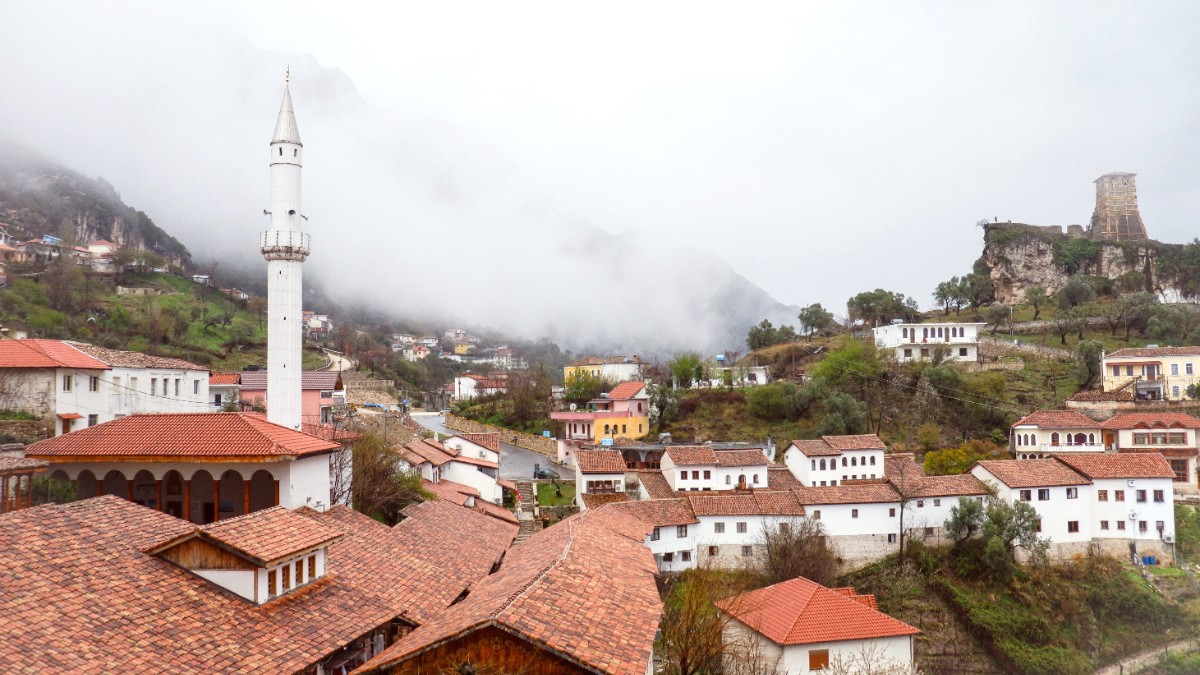
Central Albania, Albania
Typical ingredients include lamb, beef, chicken, fresh vegetables (tomatoes, peppers, eggplant, zucchini, okra), olives, olive oil, cheese (kaçkavall, djath i bardhë), yogurt, and herbs (oregano, mint, parsley, dill).
Albanian dishes are often savory and robust, using garlic, onion, and fresh herbs. The cuisine is generally less spicy than some other Balkan cuisines, depending on the quality of its fresh produce and meats.
Often light, with bread, cheese, olives, or eggs. Many guesthouses furnish a generous traditional breakfast, including savory pastries and homemade preserves.
The main meal, often a cooked dish with meat and vegetables, with fresh salad and bread.
Similar to lunch but lighter, or with meze (small appetizers) alongside a main course. Evening meals are for relaxed socializing.
This creamy, flavorful stew contains roasted peppers, tomatoes, onions, cottage cheese (or feta), and sometimes liver. It delivers a rich, comforting taste.
Find it at traditional restaurants throughout Berat.
A national dish of baked lamb and rice with a savory yogurt and egg custard topping. The yogurt bakes into a thick, tangy crust, making a comforting and unique flavor.
Widely available in traditional eateries.
A savory pastry with thin, flaky layers of dough. Fillings include cheese, spinach, or minced meat. It makes an excellent, affordable street food or quick meal.
Find it at local bakeries (furrë buke) or small cafes.
A potent fruit brandy, commonly from grapes or plums. Often homemade.
Berat is a wine-producing region. Try local red (Kallmet, Merlot) or white (Shesh i Bardhë) wines. Wineries in the region feature tastings.
While Berat has many excellent traditional restaurants, "fine dining" in the Western sense is less common. Restaurants often focus on high-quality traditional food served in a charming setting.
These restaurants provide reliable and authentic Albanian meals with comfortable settings.
For quick, affordable, and authentic food experiences.
Vegetarian options are relatively easy to find. Many traditional dishes are vegetable-based. Specify "pa mish" (without meat). Vegan options exist but with more attention to detail, specify "pa qumësht" (without milk) and "pa vezë" (without egg).
Focus on salads, grilled vegetables, rice, and beans.
Gluten-free dining presents a challenge. Wheat is a staple. Cross-contamination exists in kitchens. Communicate clearly using a Translation app or a written note for "pa gluten".
Always communicate allergies precisely. Guesthouse hosts may assist.
Some guesthouses or local tour operators may present informal cooking classes for traditional Albanian dishes.
Food tours might occur through private guides, often combined with city tours. These present insights into local markets and culinary traditions.
Informal farm visits or local produce tasting are sometimes arranged through guesthouses or specialized local tours, showing where food originates.
Dining in a traditional guesthouse (bujtina) presents an unique experience of Albanian hospitality and home-cooked meals.
May locate vegan/vegetarian options, though its coverage for Berat might be limited.
Check local listings.
Valuable for communicating dietary needs to restaurant staff.
Prepare phrases.
Berat's cuisine specifically showcases regional influences, with a focus on roasted meats, stuffed vegetables, and dairy products.
While mainly a general market, Berat Bazaar offers fresh produce, local cheeses, olives, nuts, and sometimes prepared snacks.
Berat's cuisine is typical of central and southern Albania. This region favors roasted meats, stuffed vegetables, and dairy products.
Coastal areas, like Vlorë or Sarandë, feature more seafood dishes due to their proximity to the Adriatic and Ionian seas.
Northern areas, specifically mountainous regions, might present heartier, more rustic dishes with more use of grains and wild game.
Seasonal vegetables are widely used in Albanian cooking, confirming freshness.
Lamb is popular around Easter.
No major food festivals specifically tied to Berat, but local harvest festivals or smaller community events might feature traditional foods.
Check local calendars if traveling during spring or autumn for occurrences.
Clearly communicate any dietary restrictions to restaurant staff for a better experience.
Lunch typically serves as the largest meal, while dinner often starts later in the evening.
Albanian cuisine relies on the quality of its fresh produce and meats.
Engage with guesthouse hosts about local cuisine; they often share family recipes or direct guests to the best local eateries.